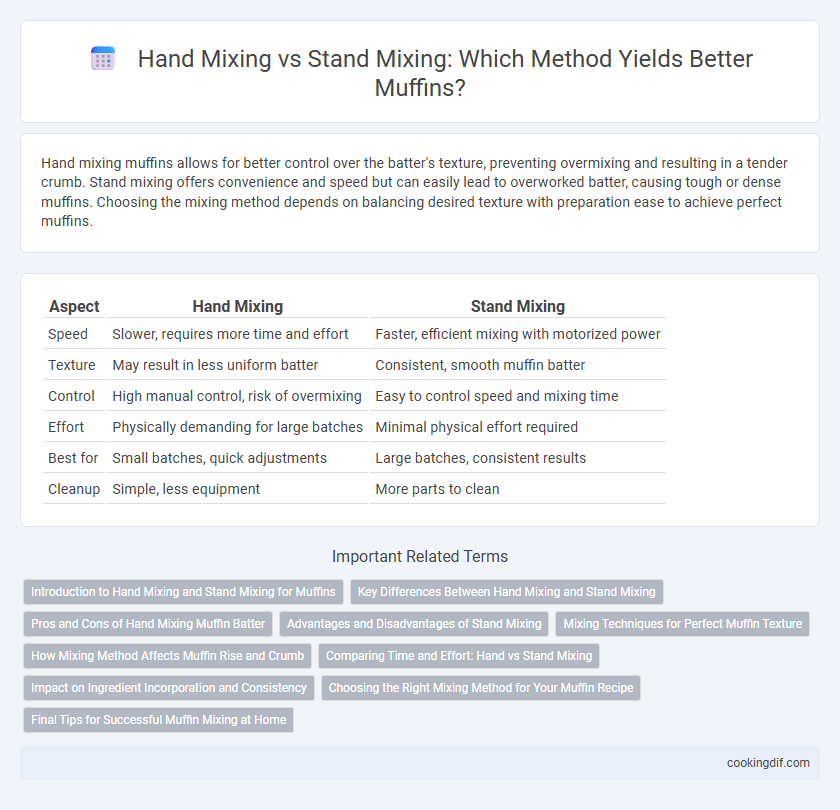Hand mixing muffins allows for better control over the batter's texture, preventing overmixing and resulting in a tender crumb. Stand mixing offers convenience and speed but can easily lead to overworked batter, causing tough or dense muffins. Choosing the mixing method depends on balancing desired texture with preparation ease to achieve perfect muffins.
Table of Comparison
| Aspect | Hand Mixing | Stand Mixing |
|---|---|---|
| Speed | Slower, requires more time and effort | Faster, efficient mixing with motorized power |
| Texture | May result in less uniform batter | Consistent, smooth muffin batter |
| Control | High manual control, risk of overmixing | Easy to control speed and mixing time |
| Effort | Physically demanding for large batches | Minimal physical effort required |
| Best for | Small batches, quick adjustments | Large batches, consistent results |
| Cleanup | Simple, less equipment | More parts to clean |
Introduction to Hand Mixing and Stand Mixing for Muffins
Hand mixing muffins involves using a whisk or spoon to combine ingredients gently, preserving texture and preventing overmixing, which can lead to dense or tough muffins. Stand mixing employs an electric mixer, offering speed and consistency, but requires careful monitoring to avoid overworking the batter. Understanding the differences helps bakers choose the appropriate method for achieving light, tender muffins with optimal crumb structure.
Key Differences Between Hand Mixing and Stand Mixing
Hand mixing muffins allows greater control over batter consistency, reducing the risk of overmixing that can lead to tough texture, while stand mixers provide consistent, fast mixing but may incorporate excess air. Stand mixers excel in efficiency for large batches but can cause gluten overdevelopment if used improperly, unlike the gentler, slower process of hand mixing. The choice depends on desired muffin texture and scale of production, balancing control with speed and consistency.
Pros and Cons of Hand Mixing Muffin Batter
Hand mixing muffin batter offers greater control over consistency and prevents overmixing, which helps maintain a tender crumb and optimal rise by avoiding gluten overdevelopment. It requires minimal equipment and is quieter, making it convenient for small batches or quick preparations but can be labor-intensive and less efficient for large quantities. Unlike stand mixers, hand mixing provides tactile feedback, allowing adjustments in real time to achieve the desired batter texture crucial for ideal muffin quality.
Advantages and Disadvantages of Stand Mixing
Stand mixing for muffin preparation offers consistent batter blending, resulting in uniform texture and improved volume. It reduces physical effort and saves time compared to hand mixing but may lead to overmixing, causing tough or dense muffins if not carefully monitored. Stand mixers provide efficient mixing for larger batches, but their use requires careful control to prevent excessive gluten development.
Mixing Techniques for Perfect Muffin Texture
Hand mixing muffins allows for gentle incorporation of ingredients, preventing overdevelopment of gluten and resulting in a tender, moist crumb. Stand mixers provide consistent speed and thorough mixing but can easily overmix, leading to dense, tough muffins if not carefully monitored. Optimal muffin texture is achieved by combining brief, controlled mixing with minimal gluten formation, favoring light hand mixing or low-speed stand mixing.
How Mixing Method Affects Muffin Rise and Crumb
Hand mixing muffins creates a gentler batter that preserves air bubbles, resulting in a lighter rise and a tender, uneven crumb structure. Stand mixers efficiently incorporate ingredients but risk overmixing, which can cause gluten development and produce a denser, tougher crumb with less volume. Optimal muffin texture is achieved by minimal mixing, protecting batter aeration regardless of the method used.
Comparing Time and Effort: Hand vs Stand Mixing
Hand mixing muffins offers greater control and requires significantly more time and physical effort, often taking 5-10 minutes to achieve a consistent batter. Stand mixers reduce preparation time to around 3-5 minutes while minimizing physical strain, providing consistent mixing through automated, high-speed motorized beaters. Choosing between hand and stand mixing hinges on balancing effort efficiency with desired batter texture and uniformity, where stand mixers often deliver faster, more reliable results.
Impact on Ingredient Incorporation and Consistency
Hand mixing allows greater control over ingredient incorporation, helping to avoid overmixing and resulting in a tender muffin crumb. Stand mixers provide consistent and thorough blending, ensuring uniform distribution of ingredients, but risk overworking the batter, leading to denser muffins. The choice between methods significantly affects muffin texture and consistency, with hand mixing favored for delicate batters and stand mixing for efficiency and homogeneity.
Choosing the Right Mixing Method for Your Muffin Recipe
Hand mixing muffins allows greater control over batter consistency, preventing overmixing that can lead to tough, dense texture. Stand mixers offer efficiency and uniform mixing but require careful monitoring to avoid developing gluten too much, which affects muffin tenderness. Selecting the right method depends on recipe sensitivity, desired crumb structure, and baking skill level for achieving optimal muffin quality.
Final Tips for Successful Muffin Mixing at Home
Hand mixing allows better control over batter consistency, reducing the risk of overmixing and resulting in tender, fluffy muffins. Stand mixers offer speed and efficiency but require careful monitoring to avoid developing gluten, which can make muffins tough. For best results, mix dry and wet ingredients just until combined, and always scrape the bowl to ensure even incorporation without excessive mixing.
Hand mixing vs Stand mixing for muffin preparation Infographic

 cookingdif.com
cookingdif.com